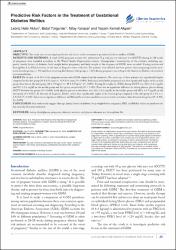| dc.contributor.author | Aktün, Lebriz Hale | |
| dc.contributor.author | Yorgunlar, Betül | |
| dc.contributor.author | Karaca, Nilay | |
| dc.contributor.author | Akpak, Yaşam Kemal | |
| dc.date.accessioned | 10.07.201910:49:13 | |
| dc.date.accessioned | 2019-07-10T19:51:20Z | |
| dc.date.available | 10.07.201910:49:13 | |
| dc.date.available | 2019-07-10T19:51:20Z | |
| dc.date.issued | 2015 | en_US |
| dc.identifier.citation | Aktün, L. H., Yorgunlar, B., Karaca, N. ve Akpak, Y. K. (2015). Predictive risk factors in the treatment of gestational diabetes mellitus. Clinical Medicine Insights-Womens Health, 8, 25-28. https://dx.doi.org/10.4137/CMWH.S31564 | en_US |
| dc.identifier.issn | 1179-562X | |
| dc.identifier.uri | https://dx.doi.org/10.4137/CMWH.S31564 | |
| dc.identifier.uri | https://hdl.handle.net/20.500.12511/2196 | |
| dc.description | WOS: 000215780200004 | en_US |
| dc.description | PubMed ID: 26508897 | en_US |
| dc.description.abstract | OBJECTIVE: This study aims to investigate predictive risk factors in the treatment of gestational diabetes mellitus (GDM). PATIENTS AND METHODS: A total of 256 pregnant tvomen who underwent 75 g oral glucose tolerance test (OGTT) during 24-28 weeks of pregnancy were included according to the World Health Organization criteria. Demographic characteristics of the patients, including age, parity, family' history of diabetes, body weight before pregnancy, and body weight at the diagnosis of GDM, were recorded. Fasting insulin and hemoglobin Ale (HbAlc) values at the time of diagnosis were evaluated. The patients were divided into two groups: those requiring insulin treatment (insulin group, n =89) and those receiving diet therapy (diet group, 71=167) during pregnancy according to the American Diabetes Association recommend ations. RESULTS: A total of 34.760 of the pregnant women with (TDM required insulin treatment. The mean age of these patients was significantly higher compared to the diet group (34.9 +/- 0.6 years vs. 31.9 0.6 years; PS 0.004). Body mass index before pregnancy was also significantly-higher in the insulin group than that in die diet group (32 0.9 kg/m(2) vs. 29 0.7 kg/m(2); P =0.004). Fasting blood glucose (FBG) during OGTT was 105.6 2.1 mg/d L and 96.7 1.1 mg/dL in the insulin group and diet group, respectively (P < 0.001). There was no significant difference in fasting plasma glucose during OGTT between the groups (P =0.069), while plasma glucose at two Flours was 161.1 +/- 6.8 mg/d L in the insulin group and 145.1 +/- 3.7 nig/dL in the diet group (P =0.027). At the dine of diagnosis, HbAlc values were significantly higher iii the insulin group compared to the diet group (5.3 0.1 vs. 4.9 0.1; P=0.001). There was no significant difference iii FBG and homeostasis model assessment -insulin resistance values between the groups (P=0.908, P=0.073). CONCLUSION: Our study results suggest that age, family history' of diabetes, body weight befivre pregnancy, FUG-, and HbAlc values are predictors for the necessity o f insulin treatment. | en_US |
| dc.language.iso | eng | en_US |
| dc.publisher | Sage Publications | en_US |
| dc.rights | info:eu-repo/semantics/openAccess | en_US |
| dc.subject | Fasting Blood Glucose | en_US |
| dc.subject | Pregnancy | en_US |
| dc.subject | Obstetric Outcome | en_US |
| dc.subject | Oral Glucose Tolerance Test | en_US |
| dc.subject | Hemoglobin A1c | en_US |
| dc.title | Predictive risk factors in the treatment of gestational diabetes mellitus | en_US |
| dc.type | article | en_US |
| dc.relation.ispartof | Clinical Medicine Insights-Womens Health | en_US |
| dc.department | İstanbul Medipol Üniversitesi, Tıp Fakültesi, Cerrahi Tıp Bilimleri Bölümü, Kadın Hastalıkları ve Doğum Ana Bilim Dalı | en_US |
| dc.authorid | 0000-0003-0640-4420 | en_US |
| dc.identifier.volume | 8 | en_US |
| dc.identifier.startpage | 25 | en_US |
| dc.identifier.endpage | 28 | en_US |
| dc.relation.publicationcategory | Makale - Uluslararası Hakemli Dergi - Kurum Öğretim Elemanı | en_US |
| dc.identifier.doi | 10.4137/CMWH.S31564 | en_US |


















